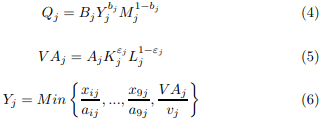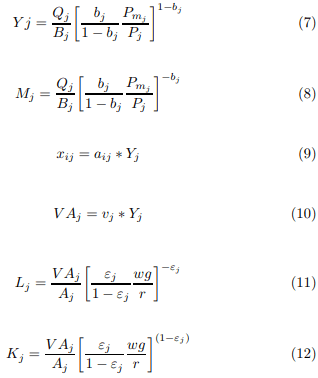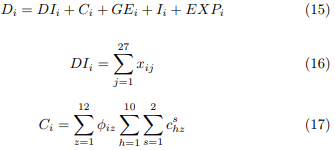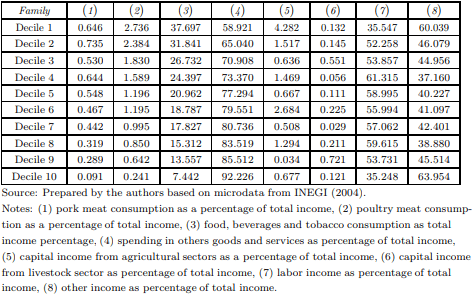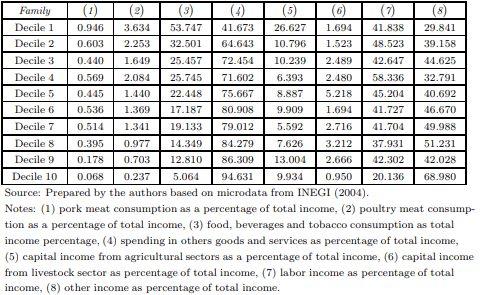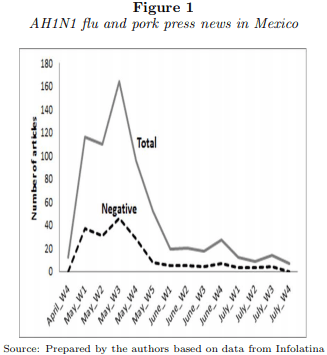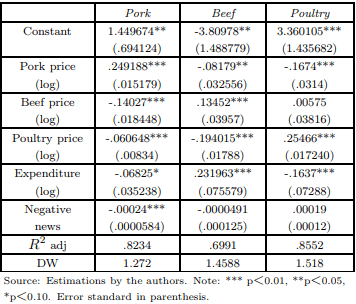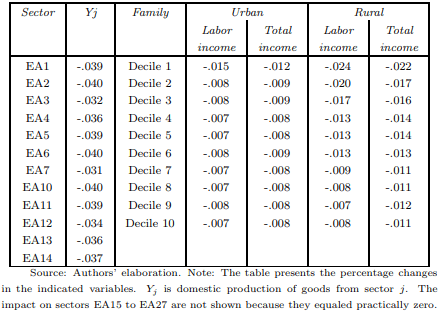1. Introduction
In April 2009, Edgar Hernández, a four year-old boy from La Gloria, El Perote in Veracruz, Mexico, was declared the first human infected with a new kind of virus that caused a type of pneumonia or severe flu. Within a few days, other residents from the same community presented the symptoms of the new disease. Since the village is 8.5 kilometers far from Carroll Farms –a subsidiary of Smithfield Foods, one of the major US swine producer–, it was first presumed that the flu was produced by a mutation of a common infection in hogs that could be transmitted to human beings. Thus, in the first days of the AH1N1 outbreak the disease was erroneously named swine flu. Fear of contagion by eating pork meat or even because of living near pig farms expanded rapidly. About 3 000 inhabitants of La Gloria protested, demanding the closure of the Carroll Farms facility, while imports of Mexican pork meat were banned by the governments of China, the Philippines, Russia, and South Korea, among others. The mistakenly alleged swine-origin of the disease was corrected shortly after, but the fear of contagion through pork meat consumption undoubtedly led many consumers to stop buying this commodity.1
The literature documenting the economic impact of epidemics on various types of meat consumption is extensive. An example of a well-documented case is the BSE (bovine spongiform encephalopathy) disease both in Europe (Burton and Young, 1996; Verbeke, Ward and Viane, 2000; Sanjuan and Dawson, 2003; Mazzochi, 2006) and abroad (Peterson and Chen, 2005; Oniki, 2006; Saghaian, Maynard and Reed, 2007; Saghaian, 2007). Also, numerous researches focus on the economic effects of recalls and information from health authorities (Kinnucan et al, 1997; Herrmann, Thompson and Krischik-Bautz, 2002; Marsh, Schroeder and Minert, 2004; Piggott and Marsh, 2004). Some studies have merged epidemiological models with economy-wide input-output models, as in Garner and Lack (1995), and Mahul and Durand (2000) who have simulated the economic impact of an outbreak of foot-and-mouth disease (FMD) in Australia and France respectively, or Tozer and Marsh (2012), and Nogueria et al. (2011) who built on this outbreak simulation but added a framework of dynamic optimization due to the depreciation and inventory properties of the cattle industry. Less common is research on how temporary misinformation during an outbreak can produce significant immediate losses to an industry. Also, few studies approach the gains of substitute types of meat that result from misinformation.
This paper offers a twofold contribution. First, to our knowledge it is one of the first attempts to quantify the effects of the AH1N1 virus on consumption and expenditure of pork meat in Mexico using an Almost Ideal Demand System (AIDS) for meat consumption in Mexico. Additionally, we have developed a general equilibrium model that captures the inter-sectoral relationships and the circular flow of income of the Mexican economy in order to obtain estimates on how the decline in pork meat consumption altered the variables production and factor demand by economic sector, and family income and expenditure by socio-demographic strata, simultaneously.
2. Methodology
2.1. Demand for meat in Mexico
Researchers have done at least three types of studies to assess the impact of information about recalls, food safety and public health: quasi-experiments, econometric models based on demand systems, and vector error correction and state-space models. Crafton, Hofier and Reilly (1981) tested the impact of recalls on demand for automobiles using the difference in difference method. The procedure requires little information, but it is necessary to have a control group, and since a control group is not always available, an econometric approach can be used in order to control for other factors that modify meat consumption besides the information about recalls, food safety and public health. Three econometric traditions have been employed, namely, the specification of theoretical driven demand systems, the use of time series methods such as cointegration, error correction and state-space models, and the estimate of discrete choice models.
Among the estimation of demand systems, the AIDS and the Rotterdam models have been extensively employed. For example, Burton and Young (1996) tested for the economic effects of the BSE (bovine spongiform encephalopathy) in the United Kingdom in the 1990s using a dynamic AIDS; Piggott and Marsh (2004) also used the AIDS model to assess the impact of public information about safety concerns on meat consumption in the United States; Oniki (2006) applied the AIDS model to evaluate the willingness to accept compensation for risk after the outbreaks of BSE and E. coli O157 in Japan. On the other hand, Peterson and Chen (2005) used the Rotterdam demand systems to assess the impact of BSE on Japanese retail meat demand; and both Marsh, Schroeder (2004) and Kinnucan et al. (1997) used the Rotterdam model to evaluate the impact of meat recalls, health information and generic advertising on meat consumption.
Recent studies have used time series relationships without assuming a prior structure of specific demand systems. Some of these studies include: Sanjuan and Dawson (2003), who estimate the impact of BSE on producer and retail prices for beef, lamb and pork using cointegration techniques; Mazzocchi (2006), who addresses the BSE food-scare Effects using a time-varying parameter approach (the Kalman Filter); Kawashima and Sari (2010), who have also studied the change in the elasticity of substitution and the country-of-origin bias using Kalman filter techniques; Herrmann, Thompson and Krischik-Bautz (2002), who employed monthly survey data to estimate the effects of both promotion expenditures and BSE information on Bavarian beef demand; Saghaian (2007) who estimates the dynamic impact of the 2003 BSE discoveryon the US beef sector using timeseries analysis and historical decomposition with weekly feedlot, wholesale, and retail beef price series; and Saghaian, Maynard and Reed (2007), who examine Japanese retail price reactions to the 2001 BSE discovery, the 2000 outbreak of foot and mouth disease (FMD), and the 1996 E. Coli food poisoning events, using historical decomposition of retail-level price series aids in explaining the behavior of beef prices in a neighborhood (period- by-period time interval) of the three events, based on an application of directed acyclic graphs, by constructing orthogonal innovations to determine causal patterns behind contemporaneous innovations. Finally, Verbeke, Ward and Viane (2000) specify discrete choice models for explaining consumer decisions to reduce fresh meat consumption in Belgium as a result of the BSE-crisis; they included demographic consumer characteristics, consumption frequency and attention to the media coverage as explanatory variables in the models.
To estimate how the fear of acquiring the AH1N1 flu impacted meat consumption in Mexico we adopted an AIDS static demand system considering the advantages it offers. AIDS is particularly useful because it is an arbitrary first-order approach to any demand system that fulfills the axioms of choice, aggregates perfectly without strong assumptions, and allows linear estimation (Deaton and Muellbauer, 1980). We only present the static case as we believe that the harm on pork meat consumption was of a once-and-for-all nature, making dynamic adjustment issues less interesting. We believe this is the case because the mistake of asserting pigs transmitted the flu was corrected within a couple of weeks by health authorities, and after four weeks of the flu outbreak the use of the term swine flu by the Mexican media diminished drastically and had practically disappeared ten weeks later.
We employed an expenditure share system for three types of meat consumption in Mexico: pork, beef and poultry, indexed.
where w represents expenditure shares, Pij are the prices, meat is total meat expenditure and P is an aggregate price index for meat. In the original AIDS model, P is given by
To keep the system linear, we used the Stone price index log(P) =

wi log(Pi) instead of (2). As Deaton and Muellbauer (1980) suggest, providing nominal prices are collinear, as they are in Mexico, the difference between using (2) and the Stone price index is minimal. To prevent simultaneity, we computed the Stone index using a one-period lag for meat expenditure shares instead of the contemporaneous ones. We are aware, though, that using the Stone index modifies the price elasticity functions, contrarily to pure AIDS specification. Thus, elasticities, when computed, were adjusted according to Green and Alston (1990), taking into account the fact that we employed one lag for the weights.
The variable F intends to capture the Effects of the fear of flu contagion caused by pork meat consumption. We discuss the options at hand in the following section. To assess the impact of AH1N1 on meat consumption (all types), we make the forecasts with and without the epidemic (i.e. F > 0 and F = 0 respectively) and take the difference in the shares.
Finally, the sum of the expenditure shares must equal one; thus, one equation is redundant. The restrictions implied by this adding up condition are:
2.2. General equilibrium model
Studies that analyze the economic impact of pandemics in a multi-sectoral context are rather scarce. In this sense, an interesting work is that of Chang et al. (2007), who analyzed the potential economic effects of an avian influenza outbreak in Taiwan using input-output techniques and a computable general equilibrium model. They found that the GDP and labor demand would potentially decline between 2 and 2.4 per cent, the sectors most likely to be affected being retail, hotels, restaurants, and air transportation. Also, Smith et al. (2009) developed a general equilibrium model to establish the economic impact of a hypothetical influenza outburst in England, considering different scenarios of vaccination Effectiveness and school closure; one of their findings was that preventive vaccination can save up to 2.3 per cent of the GDP.
In our case, we will combine econometric and multisectoral techniques to obtain a first approach. The strategy to quantify the effects of AH1N1 on the Mexican economy is as follows: first, the cutback of pork meat consumption is calculated with a partial equilibrium approach, applying econometric techniques. Second, the decrease in pork meat consumption is introduced into a general equilibrium model, assuming prices do not adjust to demand change; therefore, it is a kind of fixed price model, an extended input-output model.2
With this exercise the effects on output, factor demands, intermediate input demands and, household’s expenditure and income, can be simultaneously established; in this sense, the simulation captures the effects throughout the economic system considering the intersectoral relationships and the circular flow of income, endogenously.
The model considers 27 productive sectors; 20 family types differentiated by the income decile and socio-demographic stratum (urban and rural) they belong to; two production factors (labor and capital); and 12 consumption goods (see table 1). Explicitly, production is modeled for pork, as well as the production of their principal inputs: corn, sorghum and animal feed.
Table 1. List of economic sectors and consumption goods.
Total production (Qj) is a nested function in three levels. In the first level, domestic production (Yj) and imports (Mj) are combined to obtain total production through a Cobb-Douglas function with constant returns to scale; this function is also called the Armington aggregator (Armington 1969). In the second level, domestic production is determined using intermediate goods (xij) and added value (V Aj) in fixed proportions through a Leontief type function. Finally, in the third level, to allow for substitution among productive factors, work and capital (Lj and Kj), added value is modeled as a Cobb-Douglas function with constant returns to scale:
Assuming that producers minimize costs, domestic production demands, imports, intermediate goods, added value and production factors are:
for j,i = 1, 2, 3, ..., 27.
Where Pmj is the price of imported goods of sector j; Pj is the internal price of goods from the sector j; wg is wage; and r is return to capital. We assume that wage and return to capital are equal for all sectors.
Family income (deciles of income) of each economic stratum (INCOMEs h) comes from sales of labor and capital endowments. It is important to mention that, in the model the income each family obtains for being capital owners in the agricultural and livestock sectors are identified.
for h = 1, 2, 3 ,..., 10. s = 1, 2.
Where h stands for the income decile; s takes the value of 1 for observations in urban areas and 2 for those in rural areas; AK indicates capital assigned to agricultural sectors; LK is capital sold to livestock sectors; and RK is capital sold to all other economic sectors.
Household preferences are represented by a Cobb–Douglas utility function, homogenous of degree one. Thus, assuming that consumers maximize their utility subject to a budget constraint, consumption goods demands are estimated:
for h = 1, 2, 3, ..., 10. s = 1, 2. z = 1, 2, 3, ..., 12.
Where t is income tax; z is consumption good; and Pz is the price of consumption good z.3
It is assumed that government expenditure (GEi), investment (Ii) and exports (EXPi) are exogenous, therefore public surplus and current account are variable. The total demand (Di) for each sector i is given by
for j,i = 1, 2, 3, ..., 27. h = 1, 2, 3, ..., 10. z = 1, 2, 3, ..., 12.
Where φiz represents the proportion of the consumption good z that is produced with goods sold by sector i. Therefore, Ci are total sales of goods for private consumption of sector i.
In equilibrium, for each sector, total production must be equal to final demand. This assumption introduces simultaneity between production and consumption choices in the economy:
for i = 1, 2, 3, ..., 27.
The impact of influenza is introduced as an external shock on pork meat consumption. The model allows us to establish the immediate effects of the shock on the internal production, imports, labor and capital demand, household income and consumption, while simultaneously considering dependency relationships among generation, distribution and assignment of income (circular flow).
Since we are analyzing a demand shock but prices in the model do not respond to demand changes, in the simulation the relative price of factors and goods does not vary. The transmission mechanism of effects is the following: The demand shock is transferred to the supply side for general equilibrium condition; therefore, output, intermediate and factor demands diminish, producing household’s income and expenditure to reduce; then the impact on the supply side starts again until the model reaches convergence.
The parameters of demand functions for imports, domestic production, intermediate inputs, labor, and capital were obtained from the input-output matrix of Mexico for the year 2000 prepared by Consultoría Internacional Especializada, S. A. (CIESA).4
To calibrate the model, we adjusted the labor and capital income reported by the input-output matrix using correction factors (CF) derived from microdata in the national occupation and employment survey in Mexico for the year 2005 (INEGI, 2005). The labor income reported by the input-output matrix and the national accounts is underestimated for several reasons. First, the labor income of the self- employed is incorrectly treated as capital income (often called mixed income). Second, the income of employers is fully considered as capital income. And third, the opportunity cost of unpaid family workers is not taken into account.5 In particular, this adjustment is relevant to our research, since the agriculture and livestock sectors are more likely to have a large number of self-employed and unpaid family workers than the rest of the productive activities.6
The parameters of the income equations and consumption demands were derived from microdata in the national survey of household income and expenditure, 2004 (INEGI, 2004). Tables 2 and 3 show the income structure and average consuming trends for each income decile according to socioeconomic areas, respectively. In general, households tend to rely more on capital income from the agricultural sector than on that from the livestock sector, and they usually consume more poultry than pork meat.
Table 2. Income and expenditure patterns in Mexican households (urban area), 2004 (Percentage)
Table 3. Income and expenditure patterns in Mexican households (rural area), 2004 (Percentage)
We found interesting differences in the structures of income and consumption spending across the income deciles and between the socioeconomic areas. Capital income from agriculture is an important source of income for rural households, and particularly for the first three deciles of the rural areas. Also, it seems families tend to consume more food, beverages, tobacco and meat as their income is lower.
3. Findings
3.1. Impact on consumption of pork meat in Mexico
To assess the AIDS model for meat in Mexico we started by computing the series of pork, beef, and poultry meat consumption, adding imports to national production and subtracting meat exports; all series were provided by the Secretariat of Agriculture in Mexico (SAGARPA). Consumptions in kilograms and pesos were computed and based on that figure we established the expenditure shares for each type of meat, in a monthly basis, from January 2002 to May 2010. Monthly retail prices collected by SAGARPA for a sample of regional markets were used as proxies for the price series. The average shares for pork, beef, and poultry spending during that period were 22.4, 44.1 and 33.5 per cent respectively, while the average price per kilogram for these types of meat were 23.4 pesos for pork meat, 30.9 pesos for beef and 17 pesos for poultry.
In order to gauge the panic prompted by the flu outburst, we adopted the approach of Burton and Young (1996) and Marsh, Schoe- der and Minert (2004), who used press releases regarding the BSE and meat recalls as proxy for the public concern about the dangers of consuming meat. News that appear in the press change over time and they may actually vanish altogether; using press releases is thus a natural way to establish the relevant period in which the panic was significant –as opposed to using dummy variables where there is still the problem of choosing the starting and ending dates at which the dummy is in Effects. Here we consider only news that stress the negative side of the account regarding flu and swine -for example, news alerting the risk of flu contagion by having contact with swine; press releases concerning public panic about consuming pork meat, or on the decline in sales of pork meat products and so on. We used Infolatina’s database to search for all news articles, and after reading them we classified each note as negative, positive or neutral.
Figure 1 shows the evolution of total and negative news about connecting the AH1N1 or the flu with swine. These articles reached a peak in the fourth week of April 2009, and for some weeks 30 to 40 of them were negative. But by the last week of July, the issue had practically disappeared from the media.
Finally, we included a linear trend variable in each share equation to capture any structural change in meat consumption, and we controlled for the Lent (Cuaresma) seasonal Effects: the 40-day season of fasting and penitence observed by Catholics in preparation for Easter Sunday. The coefficients of these variables also must satisfy the adding up conditions.7
To prevent simultaneity biases and to take into account the likely correlation among the equation residuals, the AIDS model was estimated using three stage least squares. Following Henneberry and Hwang (2007), we used as instruments lagged meat prices, lagged meat expenditures, a monthly economic activity index, and the international price of grains. An iterative Zellner SUR method was employed on the second stage least square estimations.
In order to satisfy the adding up conditions, we deleted the share equation for the poultry, and estimated their coefficients and standard errors from (3). Additionally, we tested homogeneity and symmetry restrictions given by demand theory. However, evidence is not consistent with these conditions so we present just the results for the unrestricted model, imposing only the adding up condition. Table 4 presents the estimated coefficients of the main variables. As one can see, AIDS models fit very well to the Mexican meat market; almost all prices and expenditure coefficients are significantly different from zero. Expenditure elasticities are: 0.7 for pork, 1.5 for beef, and 0.5 for chicken, while the adjusted Green and Alston (1990) formulas for price elasticity of pork demand is around 0, while chicken and beef are less inelastic (-0.6 and -0.9 respectively).
The impact of AH1N1 burst on pork consumption is captured by the coefficient of the negative news variable that shows that an increase in reports related to the diminish the share of spending in pork meat. The magnitude of the coefficient of the negative news’ variable implies that from April to July 2009, the consumption of pork meat in Mexico declined by 25.5 million kilograms, that is, 1.7 per cent of the annual consumption of 2008. The losses for the industry represented 606.8 million pesos (around US$54 million at the exchange rate of that year).
3.2. Indirect and total impact on Mexican economy
In this section, we establish that a 1.7 per cent decline in pork meat consumption provoked a 0.01 per cent drop in the GDP once all the indirect effects are taken into account. This might seem a small impact, but it appears otherwise if we remember that the cause was a mistake that was corrected in less than 15 days. The economic losses amounted to $94 million, out of which $54 million were related to the decline in pork meat consumption, and $40 million to the indirect effects. Therefore, the consumption of pork meat had a multiplier impact on GDP of 1.74 ($94 million/$54 million). Let us see the whole story.
All agricultural sectors (EA1 to EA7) and manufacturing sectors of food, beverages, and tobacco (EA10 to EA14) are negatively affected by the swine flu rumor (table 5). This is because the production of grains (corn and sorghum, sectors EA1 and EA2), milling wheat products (sector EA11), and animal feed (sector EA12) are supply sources of inputs for swine breeding. Their internal production, imports and inputs demand (intermediate and primary inputs) declined between 0.03 per cent and 0.04 per cent.
Table 4. AIDS expenditure share equation system for meat in Mexico.
This is due to the following: i) inter-sectoral relationships in the livestock sector –where the impact starts– are highly concentrated in agriculture and the manufacturing sectors of food, beverages and tobacco; ii) a shock that generates a negative income Effects has repercussions on sectors that supply consumption goods that represent a high share of households’ income, such as food, beverages and tobacco, where expenditure accounts from five per cent (for the richest rural family) up to 54 per cent (for the poorest rural family) of income (see tables 2 and 3).
Table 5. Simulations results (Percentage)
The decline in labor and capital demands produced an income Effects in households. Labor income decrease ranges from 0.007 per cent (for the rural decile 9) to 0.024 per cent (for the poorest rural decile). Meanwhile, the capital income from livestock and agriculture sectors declined 0.037 per cent and 0.033 per cent, respectively.8
The observed Effects on rural households income is higher than the impact on urban ones, particularly in the poorest families. Thus, the first three income deciles in the rural area are the most affected by the shock, both in terms of income and consumption (between -0.022 per cent and -0.016 per cent).9 This is partially due to the indirect effects of influenza on the agricultural sector, since capital income from this sector accounts for 27 per cent of the poorest rural household income, 11 per cent of the rent for the second decile and 10 per cent of the income for the third decile.
4. Conclusions
This paper presents estimations of how the AH1N1 outbreak affected meat consumption and how these temporary adjustments on consumers’ preferences affected related sectors demands and therefore the incomes of rural and urban households in Mexico. Using an AIDS model, we establish that the major impact of the misperception due to the rumored swine origin of the flu epidemic was a decline of 1.7 per cent in the consumption of pork meat, that is, an estimated of US$54 million. With a general equilibrium model, we showed that the change in the consumption of pork meat should produce a decline in the GDP of 0.01 per cent, equivalent to 94 million dollars. The shock should affect the demand of grains (mainly corn and sorghum) and manufacturing sectors of food, beverages and tobacco. As a result, the farm income also declined. The income drop is relatively larger for the poorest rural households.
From this study two interesting lessons can be inferred: a baseless fear produced by the spurious origin of a new contagious disease can have significant effects on demands, accounting for one to two per cent of the annual consumption, regardless of its deceptive and momentary nature. Second, once the indirect effects through the economic system are taken into account, the economic losses may increase by two.
Clearly, these estimations can be significantly improved in several directions. First, the demand system we have estimated assumed separability between meat expenditures and the rest of the categories, as well as separability between disaggregate meat cuts by origin, although if the assumption does not hold the estimators are biased (Eales and Unnevehr 1988). According to this reasoning, not including fish in the meat category or differentiating meat by source of origin (e.g. imported pork versus domestic pork) is appropriate only if the elasticity of substitution between them and any other type of meat equals zero, which is clearly a very strong assumption (Henneberry and Mutondo 2007; Henneberry and Hwang 2007). Besides, the small coefficients of the Durbin Watson estimators in table 4 suggest modeling dynamics might be important. In this respect, it would be appropriate to test cointegration and estimate systems of error correction models (Anderson and Blundell 1983 and 1984; Eakins and Gallagher 2003).
Also, to facilitate modeling the general equilibrium effects, we focused only on the quantitative impact of the AH1N1; however, a more flexible model could also include effects on relative prices. Despite all these limitations –most of them due to the information available or to our aim at simplifying the complexities entailed by approaching the problem at the partial and general level of analysis– we believe the current model sheds light on the likely Effects of the fear produced by the AH1N1 in the early days in Mexico.
Notes
1 The outbreak of the AH1N1 influenza virus became pandemic in 2009. As some strains of the virus are endemic to humans it is also known as “human influenza”. It is a contagious respiratory disease with the same seasonal influenza symptoms; its severity depends on risk factors like age and obesity of the patients. Shrestha et al.) (2011) estimated the occurrence of 60.8 million AH1N1 cases and 12 469 deaths in the United States between April 2009 and April 2010.
2 Sobarzo (2011) explains the differences between fixed price model (input-output model) and flexible price models, and he establishes that both are applied general equilibrium models with specific assumptions. The model presented in this paper is a fixed price model, but it differs from the input-output model because in addition to intersectorial relationships it captures the circular flow of income.
3 There is an inconsistency in employing the Cobb-Douglas demand for each good, including meat, in the general equilibrium model and using the AIDS demand system for meat in the partial equilibrium model. However, the lack of symmetry in the demand specification is necessary to gain flexibility when assessing the direct first impact of AH1N1 on the meat market, with no further complexity in the estimation of the pandemic’s indirect effects on the Mexican economy
4 Due to the limited space, parameter values of the model and simulation results are not included. They are available from the authors.
5 The adjustment of labor income has been addressed by Gollin (2002), Antón (2005) and Ayala and Chapa (2011, 2014). Here we applied the method developed by Ayala and Chapa.
6 For the agriculture, livestock, forestry, hunting and fishery sectors, the correction factor is 1.40, implying that the labor income of the input-output matrix must be increased by 140 per cent in order to consider the opportunity cost of labor.
7 A recent issue in the estimation of demand systems is the variation of quality across regions and across time. Regarding the former, based in microdata, Urz´ua (2013) suggests prices hide a large variation in quality across regions in Mexico. Unfortunately, in our case, it was impossible to build a time series of regional consumption of pork, beef, and poultry based on the production series presented by the official agencies in order to deal with this issue. As for the latter, the model does not contemplate variations in quality over time; hence if quality is positively correlated with price then the problem of omitting relevant variables might arise. However, any bias for ignoring quality variations in the meat market, if present, should be rather small.
8 These effects are equal for all types of households. This is because in Mexico breeders of different types of livestock and producers of different agricultural goods are not specifically identified.
9 Besides pork meat consumption that decreases 1.7 per cent equally for all families, the spending of family f in the rest of the goods declines in the same percentage of their income.
This article was originally published in Estudios Económicos 63, enero-junio 2017, volumen 32, número 1.

